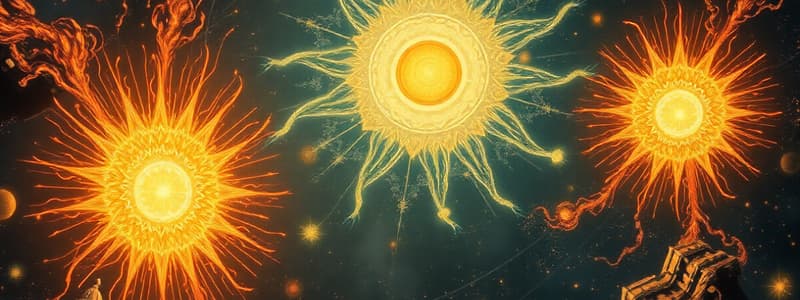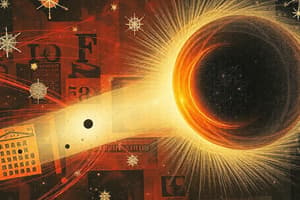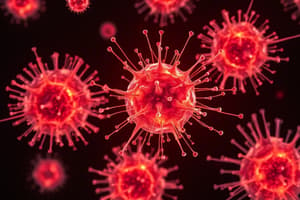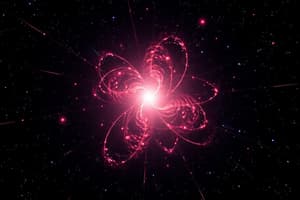Podcast
Questions and Answers
What is the most significant implication of Tak Wah Mak's discovery of the unique genetic sequence and origin of T-cell receptor genes?
What is the most significant implication of Tak Wah Mak's discovery of the unique genetic sequence and origin of T-cell receptor genes?
- It provided a foundational understanding for exploring and treating diseases related to the immune system. (correct)
- It enabled the development of techniques to directly manipulate the thymus gland's function.
- It revealed the complete genetic map of all types of white blood cells, expanding beyond T-cells.
- It allowed for immediate creation of synthetic antigens to provoke specific immune responses.
How did Tak Wah Mak's research contribute to the broader understanding of the immune system's response to cancer?
How did Tak Wah Mak's research contribute to the broader understanding of the immune system's response to cancer?
- By identifying specific antigens that are universally present in all types of cancerous cells.
- By creating a vaccine that prevents the formation of cancerous tumors in individuals with compromised immune systems.
- By developing drugs that directly target and destroy cancerous tumors without affecting the immune system.
- By applying molecular techniques to investigate and understand the immune system's reaction to cancer. (correct)
Considering the context of Tak Wah Mak's work, what was the critical challenge in immunology that his research addressed?
Considering the context of Tak Wah Mak's work, what was the critical challenge in immunology that his research addressed?
- Developing methods to culture and maintain B-cells outside of the human body for antibody production.
- Understanding how T-cells recognize and interact with antigens, substances that trigger the body’s immune response. (correct)
- Identifying the specific enzymes responsible for the replication of viral DNA within infected cells.
- Mapping the complete genetic structure of antibodies to design more effective vaccines.
What methodological approach did Tak Wah Mak employ after his initial breakthrough in identifying the unique genetic sequence of T-cell receptors?
What methodological approach did Tak Wah Mak employ after his initial breakthrough in identifying the unique genetic sequence of T-cell receptors?
If Tak Wah Mak had not discovered the unique genetic sequence of T-cell receptors, which area of immunological research would most likely have been significantly delayed?
If Tak Wah Mak had not discovered the unique genetic sequence of T-cell receptors, which area of immunological research would most likely have been significantly delayed?
What was the primary role of Jocelyn Bell Burnell in the discovery of pulsars?
What was the primary role of Jocelyn Bell Burnell in the discovery of pulsars?
Why was the discovery of pulsars initially met with some skepticism?
Why was the discovery of pulsars initially met with some skepticism?
What crucial characteristic of the radio waves detected by Jocelyn Bell Burnell and Antony Hewish led them to conclude that the waves originated from a rapidly rotating neutron star?
What crucial characteristic of the radio waves detected by Jocelyn Bell Burnell and Antony Hewish led them to conclude that the waves originated from a rapidly rotating neutron star?
What inference can be made about the scientific community's recognition of Jocelyn Bell Burnell's contribution to the discovery of pulsars, considering the 1974 Nobel Prize in Physics?
What inference can be made about the scientific community's recognition of Jocelyn Bell Burnell's contribution to the discovery of pulsars, considering the 1974 Nobel Prize in Physics?
What does Tak Wah Mak's research on T-cells reveal about the workings of the immune system?
What does Tak Wah Mak's research on T-cells reveal about the workings of the immune system?
How did Tak Wah Mak's early life experiences likely influence his career path as an immunologist and molecular biologist?
How did Tak Wah Mak's early life experiences likely influence his career path as an immunologist and molecular biologist?
What logical conclusion can be derived from Tak Wah Mak's isolation of genetic function for cancer and immunology studies using experiments with mice?
What logical conclusion can be derived from Tak Wah Mak's isolation of genetic function for cancer and immunology studies using experiments with mice?
Considering Tak Wah Mak's research on Hodgkin’s lymphoma, what is the significance of identifying a chemical to block the fuel supply of cancer cells?
Considering Tak Wah Mak's research on Hodgkin’s lymphoma, what is the significance of identifying a chemical to block the fuel supply of cancer cells?
Flashcards
What are T-cells?
What are T-cells?
White blood cells produced by the thymus gland, crucial for immune response.
What are Antigens?
What are Antigens?
Substances that trigger an immune response in the body.
What are T-cell receptors?
What are T-cell receptors?
Receptors on T-cells that recognize and bind to specific antigens.
What is the genetic sequence of T-cell receptors?
What is the genetic sequence of T-cell receptors?
Signup and view all the flashcards
What is molecular immunology in cancer?
What is molecular immunology in cancer?
Signup and view all the flashcards
Jocelyn Bell Burnell
Jocelyn Bell Burnell
Signup and view all the flashcards
Quasar
Quasar
Signup and view all the flashcards
Pulsar
Pulsar
Signup and view all the flashcards
LGM-1
LGM-1
Signup and view all the flashcards
T-cells
T-cells
Signup and view all the flashcards
Antigen
Antigen
Signup and view all the flashcards
Tak Wah Mak
Tak Wah Mak
Signup and view all the flashcards
T-cell receptor recognition
T-cell receptor recognition
Signup and view all the flashcards
Study Notes
- Jocelyn Bell Burnell was the first scientist to detect pulsars.
- Her discovery opened a new branch of astrophysics.
- Bell Burnell was born in Belfast, Northern Ireland.
- She displayed an aptitude for science at boarding school.
- She graduated from Glasgow University in 1965.
- Bell Burnell began a PhD thesis at Cambridge University, researching twinkling quasars.
- Under Antony Hewish's supervision, she helped design and build an array of radio telescopes.
- The telescopes aimed to detect quasars.
Pulsar Discovery
- In November 1967, her instruments detected radio waves pulsating every 1.337 seconds.
- The signals originated from a fixed point in space.
- Similar signals were found in other areas of space within 2 months.
- Bell Burnell and Hewish determined the radio waves came from a rapidly rotating, strongly magnetized neutron star's radiation beam.
- Each rotation emitted a pulse and was named a pulsar in 1968.
- Bell Burnell playfully named the radio waves LGM-1 (Little Green Men-1).
Recognition and Achievements
- In 1967, Bell Burnell observed a pulsar.
- Antony Hewish reported her discovery in a Nature article the following year.
- Hewish received the Nobel Prize in Physics in 1974, but Bell Burnell was not named in the award.
- She was made a Dame Commander of the British Empire (DBE) in 2007 for her contributions to astronomy.
Tak Wah Mak
- Tak Wah Mak discovered how T-cells recognize antigens.
- He advanced molecular understanding of cancer cells.
- Mak was born in southern China in 1946.
- He studied at the University of Wisconsin.
- Mak earned a PhD in biochemistry from the University of Alberta, Canada, in 1968.
T-Cell Research
- Mak's research focused on T-cells, a type of white blood cell produced by the thymus gland.
- His research solved how receptors on T-cells recognize antigens.
- In 1983, he discovered T-cell receptors' genes have a unique genetic sequence and origin.
- This discovery led to new advances in treating immune-system diseases.
- Mak applied molecular techniques to study immune responses to cancer.
Career milestones
- Mak accepted a fellowship at the Ontario Cancer Institute in 1972 after completing his doctorate.
- He detailed the genetic encoding of human T-cell receptors in the March 1984 edition of Nature journal.
- Mak used mice experiments to isolate genetic function for cancer and immunology studies in 1988.
- He identified a chemical to block Hodgkin’s lymphoma in 1999.
Studying That Suits You
Use AI to generate personalized quizzes and flashcards to suit your learning preferences.
Description
Jocelyn Bell Burnell, while a student, detected radio waves pulsating every 1.337 seconds. The signals originated from a fixed point in space. These signals were found to be from rapidly rotating, strongly magnetized neutron stars, and named pulsars.





